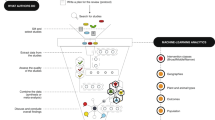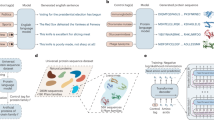Abstract
Several factors have traditionally hampered the effectiveness of agricultural extension services, including limited institutional capacity and reach. Here we assess the potential of large language models (LLMs), specifically Generative Pre-trained Transformer (GPT), to transform agricultural extension. We focus on the ability of LLMs to simplify scientific knowledge and provide personalized, location-specific and data-driven agricultural recommendations. We emphasize shortcomings of this technology, informed by real-life testing of GPT to generate technical advice for Nigerian cassava farmers. To ensure a safe and responsible dissemination of LLM functionality across farming worldwide, we propose an idealized LLM design process with human experts in the loop.
This is a preview of subscription content, access via your institution
Access options
Access Nature and 54 other Nature Portfolio journals
Get Nature+, our best-value online-access subscription
$29.99 / 30 days
cancel any time
Subscribe to this journal
Receive 12 digital issues and online access to articles
$119.00 per year
only $9.92 per issue
Buy this article
- Purchase on Springer Link
- Instant access to full article PDF
Prices may be subject to local taxes which are calculated during checkout

Similar content being viewed by others
Change history
30 November 2023
A Correction to this paper has been published: https://doi.org/10.1038/s43016-023-00904-9
References
Anderson, J. R. & Feder, G. in Handbook of Agricultural Economics Vol. 3, 2343–2378 (North Holland, 2007).
Norton, G. W. & Alwang, J. Changes in agricultural extension and implications for farmer adoption of new practices. Appl. Econ. Perspect. Policy 42, 8–20 (2020).
Lowder, S. K., Skoet, J. & Raney, T. The number, size, and distribution of farms, smallholder farms, and family farms worldwide. World Dev. 87, 16–29 (2016).
Ricciardi, V., Ramankutty, N., Mehrabi, Z., Jarvis, L. & Chookolingo, B. How much of the world’s food do smallholders produce? Glob. Food Secur. 17, 64–72 (2018).
Rutatora, D. F. & Mattee, A. Z. Major agricultural extension providers in Tanzania. Afr. Study Monogr. 22, 155–173 (2001).
Performance Audit Report, India: Third National Agricultural Extension Project (World Bank, 1998); https://documents1.worldbank.org/curated/en/927501510758592216/pdf/multi-page.pdf
National Agricultural Extension Program (NAEP) (World Bank, 2023); https://projects.worldbank.org/en/projects-operations/project-detail/P002753
Alston, J. M., Chan-Kang, C., Marra, M. C., Pardey, P. G. & Wyatt, T. J. A Meta-analysis of Rates of Return to Agricultural R&D: Ex Pede Herculem? Report No. 113 (IFPRI, 2000).
Bergamasco, M. P. P. & Borsatto, S. R. Evaluation of Extension Reforms in Brazil (IFPRI, 2016).
Davis, K. et al. In-depth Assessment of the Public Agricultural Extension System of Ethiopia and Recommendations for Improvement Discussion Paper No.1041, 193–201 (IFPRI, 2010).
Berhanu, K. & Poulton, C. The political economy of agricultural extension policy in Ethiopia: economic growth and political control. Dev. Policy Rev. 32, s197–s213 (2014).
Ochola, J. N. & Manyasi, A. B. Agricultural extension services: challenges and barriers to effectiveness. J. Agric. Educ. Extension 18, 2 (2012).
Eberhard, D. M. et al. Ethnologue: Languages of the World (SIL International, 2023).
Labarthe, P. & Laurent, C. Privatization of agricultural extension services in the EU: towards a lack of adequate knowledge for small-scale farms? Food Policy 38, 240–252 (2013).
Rajkhowa, P. & Qaim, M. Personalized digital extension services and agricultural performance: evidence from smallholder farmers in India. PLoS ONE 16, e0259319 (2021).
Prager, K. & Creaney, R. Achieving on-farm practice change through facilitated group learning: evaluating the effectiveness of monitor farms and discussion groups. J. Rural Stud. 56, 1–11 (2017).
Labarthe, P. & Laurent, C. The importance of the back‐office for farm advisory services. EuroChoices 12, 21–26 (2013).
Kothari, J. D. Plant disease identification using artificial intelligence: machine learning approach. Int. J. Innov. Res. Comput. Commun. Eng. 7, 11082–11085 (2018).
Mrisho, L. M. et al. Accuracy of a smartphone-based object detection model, PlantVillage Nuru, in identifying the foliar symptoms of the viral diseases of cassava–CMD and CBSD. Front. Plant Sci. 11, 590889 (2020).
Plantix (Plantix, accessed 9 May 2023); https://plantix.net/en/
Scaling Up Telecommunications and Digital Technology for Food Security: PlantVillage (FAO, 2021); https://www.fao.org/north-america/news/detail/en/c/1418126/
Fabregas, R., Kremer, M. & Schilbach, F. Realizing the potential of digital development: the case of agricultural advice. Science 366, eaay3038 (2019).
McCampbell, M., Adewopo, J., Klerkx, L. & Leeuwis, C. Are farmers ready to use phone-based digital tools for agronomic advice? Ex-ante user readiness assessment using the case of Rwandan banana farmers. J. Agric. Educ. Extension 29, 29–51 (2023).
Steinke, J. et al. Tapping the full potential of the digital revolution for agricultural extension: an emerging innovation agenda. Int. J. Agric. Sustain. 19, 549–565 (2021).
Ingram, J. & Maye, D. What are the implications of digitalisation for agricultural knowledge? Front. Sustain. Food Syst. 4, 66 (2020).
Fielke, S., Taylor, B. & Jakku, E. Digitalisation of agricultural knowledge and advice networks: a state-of-the-art review. Agric. Syst. 180, 102763 (2020).
Radford, A., Narasimhan, K., Salimans, T. & Sutskever, I. Improving Language Understanding by Generative Pre-training (OpenAI, 2018).
Klerkx, L. Digital and virtual spaces as sites of extension and advisory services research: social media, gaming, and digitally integrated and augmented advice. J. Agric. Educ. Extension 27, 277–286 (2021).
Can ChatGPT revolutionise agriculture? Financial Express (4 March 2023); https://www.financialexpress.com/life/technology-can-chatgpt-revolutionise-agriculture-heres-what-farmers-can-do-with-it-2999456/
Bender, E. M., Gebru, T., McMillan-Major, A. & Shmitchell, S. On the dangers of stochastic parrots: can language models be too big? In Proc. 2021 ACM Conference on Fairness, Accountability, and Transparency 610–623 (ACM Proceedings, 2021).
Eastwood, C., Ayre, M., Nettle, R. & Rue, B. D. Making sense in the cloud: farm advisory services in a smart farming future. NJAS 90, 100298 (2019).
Klerkx, L., Jakku, E. & Labarthe, P. A review of social science on digital agriculture, smart farming and agriculture 4.0: new contributions and a future research agenda. NJAS 90, 100315 (2019).
Wilkinson, M. D. et al. The FAIR Guiding Principles for scientific data management and stewardship. Sci. Data 3, 1–9 (2016).
Chowdhury, A., Kabir, K. H., Abdulai, A. R. & Alam, M. F. Systematic review of misinformation in social and online media for the development of an analytical framework for agri-food sector. Sustainability 15, 4753 (2023).
Schaul, K., Chen, S. Y. & Tiku, N. Inside the secret list of websites that make AI like ChatGPT sound smart. The Washington Post (19 April 2023); https://www.washingtonpost.com/technology/interactive/2023/ai-chatbot-learning
Wiseman, L., Sanderson, J., Zhang, A. & Jakku, E. Farmers and their data: An examination of farmers’ reluctance to share their data through the lens of the laws impacting smart farming. NJAS 90, 100301 (2019).
Stilgoe, J., Owen, R. & Macnaghten, P. Developing a framework for responsible innovation. Res. Policy 42, 1568–1580 (2013).
Bellon-Maurel, V. et al. Digital revolution for the agroecological transition of food systems: a responsible research and innovation perspective. Agric. Syst. 203, 103524 (2022).
Eastwood, C., Klerkx, L., Ayre, M. & Dela Rue, B. Managing socio-ethical challenges in the development of smart farming: from a fragmented to a comprehensive approach for responsible research and innovation. J. Agric. Enviro. Ethics 32, 741–768 (2019).
Tzachor, A., Devare, M., King, B., Avin, S. & Ó hÉigeartaigh, S. Responsible artificial intelligence in agriculture requires systemic understanding of risks and externalities. Nat. Mach. Intell. 4, 104–109 (2022).
Acknowledgements
This Perspective was made possible by a grant from Templeton World Charity Foundation and CGIAR’s Excellence in Agronomy Initiative and the Digital Innovation Initiative, largely funded by the Bill and Melinda Gates Foundation. The opinions expressed in this publication are those of the author(s) and do not necessarily reflect the views of Templeton World Charity Foundation.
Author information
Authors and Affiliations
Contributions
All authors developed the Perspective jointly and contributed to writing the text.
Corresponding author
Ethics declarations
Competing interests
The authors declare no competing interests.
Peer review
Peer review information
Nature Food thanks Pallavi Rajkhowa and the other, anonymous, reviewer(s) for their contribution to the peer review of this work.
Additional information
Publisher’s note Springer Nature remains neutral with regard to jurisdictional claims in published maps and institutional affiliations.
Supplementary information
Supplementary Data 1
Supplementary Data for Box 2.
Rights and permissions
Springer Nature or its licensor (e.g. a society or other partner) holds exclusive rights to this article under a publishing agreement with the author(s) or other rightsholder(s); author self-archiving of the accepted manuscript version of this article is solely governed by the terms of such publishing agreement and applicable law.
About this article
Cite this article
Tzachor, A., Devare, M., Richards, C. et al. Large language models and agricultural extension services. Nat Food 4, 941–948 (2023). https://doi.org/10.1038/s43016-023-00867-x
Received:
Accepted:
Published:
Issue Date:
DOI: https://doi.org/10.1038/s43016-023-00867-x



